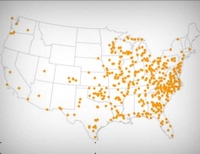Who wants to bring prison-based gerrymandering back to New York?
Somebody wants to bring prison-based gerrymandering back to New York. But who? It's not upstate counties or upstate newspapers.
by Peter Wagner, April 5, 2011
Somebody wants to bring prison-based gerrymandering back to New York. But who?
It’s not the 13 upstate New York counties that have historically rejected the idea of using prison populations to pad some legislative districts with prisons at the expense of all other districts. In fact, one of those counties even passed a local law declaring that:
“Persons incarcerated in state and federal correctional institutions live in a separate environment, do not participate in the life of Essex County and do not affect the social and economic character of the towns…. The inclusion of these federal and state correctional facility inmates unfairly dilutes the votes or voting weight of persons residing in other towns within Essex County….”
It’s not the editorial board of the Times Herald-Record in Orange County New York which editorialized that:
“… a politician should be embarrassed to claim that people held in prisons should count as constituents.”
And it’s not the editorial board of the Observer-Dispatch in Oneida County, which was outraged to learn about the extent of prison-based gerrymandering in local city and county government:
“In January, it was reported that the 6,000-plus prison inmates at Oneida County’s four prisons are factored into population totals for county legislative districts in Marcy and Rome. Meanwhile, in the city of Rome, nearly half the people in the Second Ward are prisoners. That means a non-prisoner in the Second Ward has twice the clout on the Common Council over a resident in another part of the city. That’s wrong.”
The paper ended their editorial with an unsuccessful call for a particular important person to support New York’s landmark law to end prison-based gerrymandering.
So if the upstate county governments think prison-based gerrymandering is a bad idea, and if the upstate editorial boards think prison-based gerrymandering is unfair, is there any group that may have a different perspective?
The video below explains which group sees enough self-interest in prison-based gerrymandering to want to file a lawsuit to bring back the repugnant practice:



